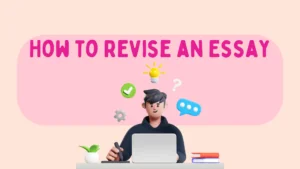Ever stared at an assignment that tells you to write a character analysis essay and thought, “Where do I even begin?” You’re not alone. This type of essay might seem tricky at first, especially if you’re unsure what to write about or how to start. But don’t worry—it’s not as complicated as it seems. Imagine you’re just getting to know a new friend and want to figure out who they are as a person. That’s pretty much what you’ll be doing in a character analysis essay. You’ll dig into a character’s personality, motivations, and actions to understand them better. Sounds interesting, right? Let’s break it down together so you can tackle this assignment with confidence.

✅ AI Essay Writer ✅ AI Detector ✅ Plagchecker ✅ Paraphraser
✅ Summarizer ✅ Citation Generator
What Is a Character Analysis
When learning how to analyze a character, you should put on a detective hat and figure out what makes a character from a story act, change, and reach their goals. But instead of looking for clues at a crime scene, you’re looking at how a character behaves, what they say, and how they interact with other characters. You are digging deeper into their personality, motives, and actions to understand them on a more meaningful level.
To break it down, start by asking yourself what kind of person this character is. Next, think about why they do what they do. What’s driving them? Lastly, pay attention to how they change throughout the story. Do they learn something new, become better or worse, or stay the same?
When you analyze a character, you’re not just describing them—you’re exploring the reasons behind their choices and how those choices affect the story. You are peeling back layers to see what’s really going on inside their head and heart. By the end, you should be able to explain why this character matters and what their journey means in the context of the story.
How to Write a Character Analysis: Where to Start
Starting a character analysis essay can be a bit daunting, but with the right approach, you can break it down into manageable steps. Here are some practical tips to help you get started on the right foot.
1. Choose a Character That Interests You
The first step is to pick a character that grabs your attention. It’s much easier to write about someone you find intriguing rather than someone you have no connection with. If you have the freedom to choose, go for a character that plays a significant role in the story or one that stands out to you. A strong interest in the character will make the analysis more engaging for both you and your readers.
2. Take Notes While You Read
As you read the story, keep a notebook or a document open to jot down important details about the character. Pay attention to their actions, dialogue, and how other characters react to them. Taking notes will help you keep track of key moments and traits that you might want to include in your essay later. This will also make it easier to find quotes and examples to support your analysis.
3. Focus on Specific Traits and Developments
When analyzing a character, don’t try to cover everything about them. Instead, focus on a few key traits or developments that define them. For instance, you might want to explore how a character grows throughout the story or how a particular trait, like bravery or jealousy, influences their decisions. Narrowing down your focus will make your essay more cohesive and insightful.
4. Use Evidence from the Text
Support your analysis with evidence from the story. This means using direct quotes, descriptions, and specific scenes to back up your points. If you say a character is brave, show an example where they acted courageously. This not only strengthens your argument but also shows that you have a deep understanding of the text.
5. Create an Outline Before Writing
Before diving into the actual writing, it’s helpful to create an outline. This doesn’t have to be anything fancy—just a basic plan that maps out the structure of your essay. Start with an introduction that briefly describes the character and their role in the story. Then, plan out your body paragraphs, each focusing on a specific aspect of the character. Finally, wrap it up with a conclusion that ties everything together. An outline will keep your essay organized and make the writing process smoother.
10 Questions to Help You Start Your Character Analysis Essay
Once you’ve got these tips down, you might still need a little push to get the ideas flowing. Here are some questions to help you dig deeper into your character and kickstart your analysis:

These questions can serve as a guide to help you to explore different aspects of the character and find interesting angles for your essay. After answering them, you’ll gather the insights you need and practically do half the work already.
Character Analysis Essay Outline
When writing a character analysis essay, having a clear outline can make the process much easier. Think of the outline as a guide through the different sections of your essay, where you cover all the important points without getting lost along the way. Here’s a basic structure you can follow, along with an example based on the main character from the movie Poor Things.
📍 Introduction
The introduction is where you set the stage for your essay. Start by briefly introducing the character you’re analyzing and the story they come from. Then, include a thesis statement that outlines the main points you’ll be discussing about the character. This is like giving your readers a sneak peek at what’s to come.
Example: In Poor Things, the character Bella Baxter stands out as a unique and complex person. Reanimated after her death, Bella’s journey of self-discovery and reclaiming her identity serves as the heart of the story. This essay will explore Bella’s transformation, her relationships, and how her quest for autonomy shapes her character.
📍 Background Information
Before diving into the analysis, provide some background on the character. This might include their role in the story, their relationships with other characters, and any significant events that have impacted them. This section gives your readers the context they need to understand your analysis.
Example: Bella begins her life anew, literally, after being brought back to life by a scientist. She starts as a blank slate, with no memories of her past, and is curious about the world around her. Her childlike innocence and unfiltered curiosity make her interactions with others both endearing and challenging.
📍 Character Traits
Now it’s time to analyze the character’s traits. Pick two or three key characteristics that define the character and discuss how these traits influence their actions and decisions. Use specific examples from the story to support your points.
Example: One of Bella’s defining traits is her insatiable curiosity. This curiosity drives her to explore new experiences and question the world around her, often leading to both humorous and poignant moments. However, it also makes her vulnerable to manipulation by others who try to control her newfound freedom.
📍 Character Development
In this section, discuss how the character changes throughout the story. Do they grow or regress? How do the events of the story shape their development? This is where you show the character’s journey and how they evolve from beginning to end.
Example: As the story progresses, Bella evolves from a naive and dependent individual into a more confident and independent woman. Her experiences teach her about the complexities of human relationships and the importance of self-determination. By the end of the film, Bella is no longer just a creation; she is her own person, with a clear sense of who she is and what she wants.
📍 Conclusion
Wrap up your essay with a conclusion that summarizes your main points and reiterates your thesis. This is your chance to reflect on the character’s significance in the story and what readers can learn from their journey.
Example: Bella Baxter’s journey in Poor Things is an exploration of identity, autonomy, and the human experience. Through her transformation, she becomes a symbol of the struggle to define oneself in a world that often seeks to impose its own definitions. Bella’s story reminds of the importance of curiosity, growth, and the courage to carve out our own path.
Putting It All Together
With this outline, you have a solid structure to follow when writing your character analysis essay. Start with an engaging introduction, provide the necessary background, dive into the character’s traits and development, and then tie it all together with a thoughtful conclusion. And remember, the key is to keep your analysis focused and supported by evidence from the story.
What to Avoid When Writing a Character Analysis
When writing a character analysis, there are a few common things that can make your essay less effective. It is very easy to miss them, and there’s nothing particularly catastrophic about it, but such mistakes can hinder the overall impression and flunk all of your hard work a bit.
 Avoid Summarizing the Plot
Avoid Summarizing the Plot
One of the biggest mistakes you can make is turning your character analysis into a summary of the story. A big no-no! It’s easy to fall into this trap, especially if you’re trying to explain where the character fits into the plot. However, your goal is to analyze the character, not retell the story. Instead of summarizing, focus on how specific events in the plot reveal something important about the character. For example, instead of describing every event that happens to the character, talk about a few key moments that show their personality, growth, or motivations.
 Don’t Rely on Generalizations
Don’t Rely on Generalizations
Another thing to avoid is making general statements that don’t add much value to your analysis. Saying something like “the character is nice” or “the character is mean” doesn’t really tell your reader anything interesting. Okay, they’re nice, and? It’s too vague and doesn’t offer any real insight into who the character is or why they behave the way they do. Instead, be specific and use examples from the text to support your points. Instead of saying “the character is brave,” you could say, “the character shows bravery when they stand up to the antagonist despite being outnumbered.”
 Steer Clear of Overcomplicating Your Analysis
Steer Clear of Overcomplicating Your Analysis
While it’s important to dig deep into the character, avoid overcomplicating your analysis with unnecessary jargon or overly complex ideas. Remember, the goal is to make your essay clear and understandable, especially for your readers who might not be familiar with the story. Keep your language simple and focus on explaining your points clearly rather than trying to impress with big words or complicated sentences. Your readers will appreciate an essay that’s easy to follow and gets to the point.
Of course, this is not a case for every single assignment. If you are enrolledin a specific class, for example, about film, while pursuing a film major, you have to show some sort of expertise on the topic. In this case, it might be better to “show’em what you got.” However, when writing for a high school literature class, it is very easy to get tangled up in all of the things you want to say and simply create a messy piece.
 Avoid Ignoring the Character’s Flaws
Avoid Ignoring the Character’s Flaws
It’s tempting to focus only on the positive traits of a character, especially if they’re the hero of the story. However, a well-rounded character analysis should look at both strengths and weaknesses. After all, the perfect person doesn’t exist, and the appeal of a good character lies in their inner conflict. Ignoring a character’s flaws can make your analysis feel incomplete or one-sided. Consider how the character’s flaws impact their decisions and the story as a whole. This will give your analysis more depth and make it more interesting to read. For example, if a character is known for being courageous, but their bravery is borderline recklessness, that’s worth discussing.
And that is pretty much it! Writing a character analysis essay might make you want to procrastinate for hours on end, but when knowing what to do, it can become a very interesting experience that will make you proud of your work. And probably get you an A+ 😉
FAQ
Follow us on Reddit for more insights and updates.





Comments (0)
Welcome to A*Help comments!
We’re all about debate and discussion at A*Help.
We value the diverse opinions of users, so you may find points of view that you don’t agree with. And that’s cool. However, there are certain things we’re not OK with: attempts to manipulate our data in any way, for example, or the posting of discriminative, offensive, hateful, or disparaging material.